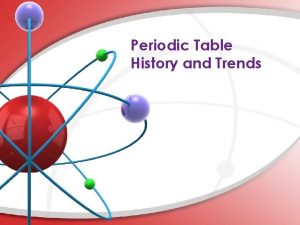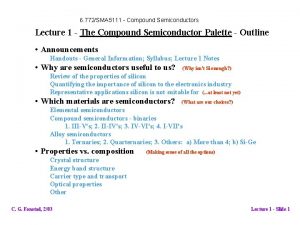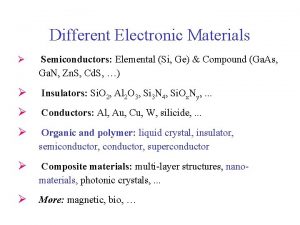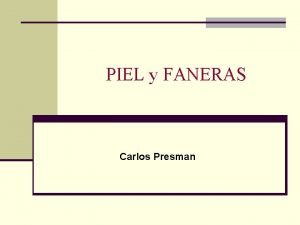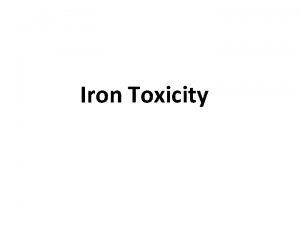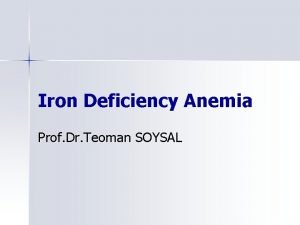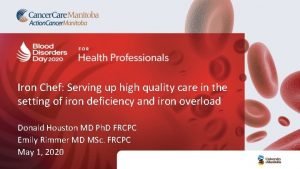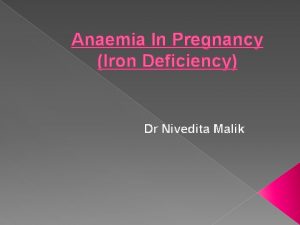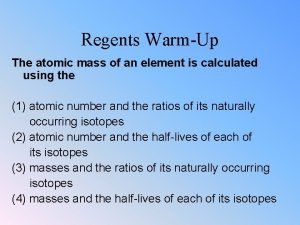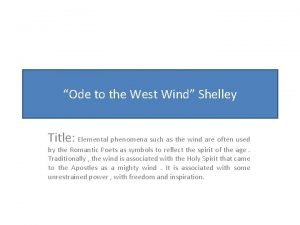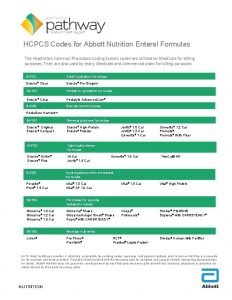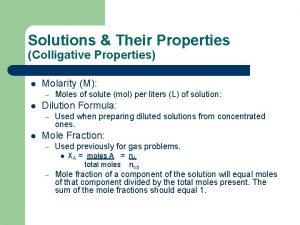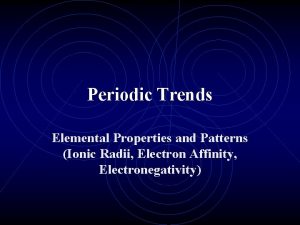Periodic Trends Elemental Properties and Patterns The Periodic
































- Slides: 32

Periodic Trends Elemental Properties and Patterns

The Periodic Law • Dmitri Mendeleev - first to publish an organized periodic table of known elements.

The Periodic Law • Mendeleev even predicted the properties of undiscovered elements. https: //www. youtube. com/watch? v=f. Pnw. BITSmg. U

The Periodic Law • Says that: “When arranged by increasing atomic number, the chemical elements display a regular and repeating pattern of chemical and physical properties. ”

So… • Atoms with similar properties appear in groups or families (vertical columns) on the periodic table. • They are similar because they all have the same number of valence (outer shell) electrons, which determines their chemical behavior.

Valence Electrons • For Groups 1, 2, 13, 14, 15, 16, 17, 18: The digit farthest to the right is the number of valence electrons. Example: 15 • Groups 3 -12? • Many have 1 -2, but figuring it out is more complicated.

A Different Type of Grouping Besides the 4 blocks of the table, there is another way of classifying element: • Metals • Nonmetals • Metalloids

Metals, Nonmetals, Metalloids

Metals, Nonmetals, Metalloids • Most elements that border the stair case are metalloids. (“metal-like”) Have properties of both metals and nonmetals!

Metals • Lustrous (shiny), malleable, ductile, and are good conductors of heat and electricity. • Mostly hard – not brittle • They are mostly solids at room temp.

Nonmetals • The opposite! • They are dull, brittle, nonconductors (insulators). • Some are solid, but many are gases, and a few are liquid.

Metalloids • Have properties both metals & nonmetals! • Shiny but brittle. • Semiconductors.

The Octet Rule • The “goal” of most atoms (except H, Li and Be) is to have an octet (group of 8 electrons) in their valence energy level. • Metals generally give electrons, nonmetals take them from other atoms. Remember… • Atoms that have gained or lost electrons are called ions.

Ions • When an atom gains an electron, it becomes negatively charged and is called an (anion. ) • When an atom loses an electron, it becomes positively charged (cation). Think of the “t” like a “+” sign.

Cation Formation Effective nuclear charge on remaining electrons increases. Na atom 1 valence electron 11 p+ Valence elost in ion formation Result: a smaller sodium cation, Na+ Remaining e- are pulled in closer to the nucleus. Ionic size decreases.

Anion Formation Chlorine atom with 7 valence e 17 p+ One e- is added to the outer shell. Effective nuclear charge is reduced and the e- cloud expands. A chloride ion is produced. It is larger than the original atom.





Periodic Trends • There are several important atomic characteristics that show predictable trends that you should know. • The first and most important is atomic radius.

Atomic Radius • Is the distance from the center of the nucleus to the “edge” of the electron cloud. • Since that is difficult to define, scientists use covalent radius, half the distance between the nuclei of 2 bonded atoms. • Atomic radii are usually measured in picometers (pm) or angstroms (Å). An angstrom is 1 x 10 -10 m.

Covalent Radius • Two Br atoms bonded together are 2. 86 angstroms apart. So, the radius of each atom is 1. 43 Å. 2. 86 Å 1. 43 Å

Atomic Radius The trend for atomic radius in a GROUP is to go from smaller at the top to larger at the bottom. • Why? • With each step down the family, we add energy levels to the electron cloud, making the atoms larger.

Atomic Radius • As you move ACROSS a PERIOD, atoms are smaller because of an increased attraction between nucleus and electron cloud. • The increased attraction pulls the cloud in, making atoms smaller as we move from left to right.

Effective Nuclear Charge • What keeps electrons from simply flying off into space? • Effective nuclear charge is the pull that an electron “feels” from the nucleus. • The closer an electron is to the nucleus, the more pull it feels. • As effective nuclear charge increases, the electron cloud is pulled in tighter.

Ionization • If an electron is given enough energy to overcome its attraction to the nucleus, it can leave the atom completely. • The atom has been “ionized” or charged. • Number of protons ≠ number of electrons.

Ionization Energy • Energy required to remove an electron from an atom is ionization energy. (measured in kilojoules, k. J) • The larger the atom is, the easier its electrons are to remove. • Ionization energy and atomic radius are inversely proportional. • As you move down, it decreases! • As you move across, it increases!

Electronegativity • Electronegativity is a measure of an atom’s attraction for another atom’s electrons. • Metals are usually electron givers and have low electronegativity. • Nonmetals are electron takers and have high electronegativity. • What about the noble gases? Make a prediction to your table partners.

Ionic Radius • Cations are always smaller than the original atom. • Conversely, anions are always larger than the original atom.

Review Video for Atomic Trends • https: //www. youtube. com/watch? v=0 t. P 6 b. V 89 log

Link to bonding animations • http: //bcs. whfreeman. com/thelifewire/conte nt/chp 02/02020. html • http: //www. youtube. com/watch? v=c. Zy 8 t. GF V 8 QE&list=TL 6 TJ_jx 1 X 7 SKn. BP 20 k. At 90 e Sd. Tpg. QOR 8 H
 Nuclear charge definition
Nuclear charge definition Periodic trends in elemental properties
Periodic trends in elemental properties Periodic trends in elemental properties
Periodic trends in elemental properties Periodic tremds
Periodic tremds Periodic trends in properties of elements
Periodic trends in properties of elements 15/999 mass street periodic table, o 8
15/999 mass street periodic table, o 8 A visual aid used to show statistical trends and patterns.
A visual aid used to show statistical trends and patterns. A visual aid used to show statistical trends and patterns
A visual aid used to show statistical trends and patterns Quarternaries
Quarternaries Elemental and compound semiconductors
Elemental and compound semiconductors Eclat algorithm
Eclat algorithm Effective therbligs
Effective therbligs Elemental analysis of beer
Elemental analysis of beer Unidad elemental
Unidad elemental Verruga vulgar
Verruga vulgar Elemental iron dose
Elemental iron dose Lenfadenomegali
Lenfadenomegali Elemental iron dose
Elemental iron dose Semielemental
Semielemental Características de la educación física
Características de la educación física Complications of anemia
Complications of anemia Elemental iron dose
Elemental iron dose Elemental state
Elemental state Caracteristica de la disciplina
Caracteristica de la disciplina Elemental balance in bioprocess
Elemental balance in bioprocess Steady state vs equilibrium
Steady state vs equilibrium Ode to the elemental rainbow
Ode to the elemental rainbow Glucerna cpt code
Glucerna cpt code Nanodiodo
Nanodiodo Dc motors
Dc motors Gimnasia elemental
Gimnasia elemental Elemental tetrad
Elemental tetrad Is molarity a colligative property
Is molarity a colligative property




